Business Decision Making Essay: University of Suffolk BABS Assignment
VerifiedAdded on 2022/12/05
|8
|1300
|346
Essay
AI Summary
This essay provides a comprehensive analysis of business decision-making processes, focusing on the application of investment appraisal techniques. The essay begins with an introduction to the decision-making process within a business context, followed by a detailed calculation of the payback period and Net Present Value (NPV) for two hypothetical projects, Project A and Project B. The main body of the essay compares and contrasts these two techniques and analyses the financial and non-financial factors influencing business decisions, including return on investment, cost-benefit analysis, equipment standardization, and human and social factors. The essay concludes by summarizing the key findings and emphasizing the importance of considering both financial and non-financial aspects when evaluating investment opportunities. The essay references relevant academic literature to support its analysis and conclusions.

Project (individual essay)
1
1
Paraphrase This Document
Need a fresh take? Get an instant paraphrase of this document with our AI Paraphraser
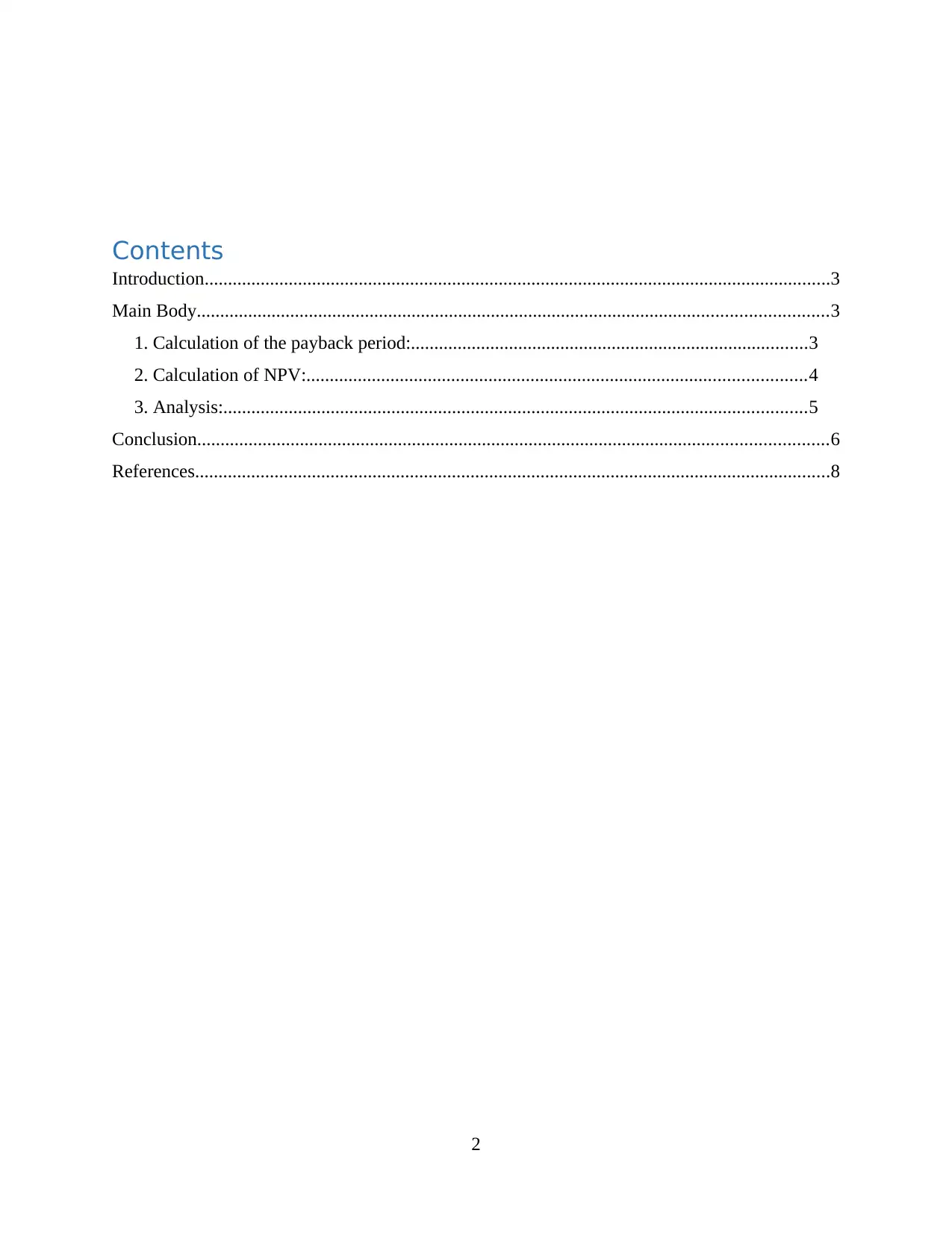
Contents
Introduction......................................................................................................................................3
Main Body.......................................................................................................................................3
1. Calculation of the payback period:.....................................................................................3
2. Calculation of NPV:...........................................................................................................4
3. Analysis:.............................................................................................................................5
Conclusion.......................................................................................................................................6
References........................................................................................................................................8
2
Introduction......................................................................................................................................3
Main Body.......................................................................................................................................3
1. Calculation of the payback period:.....................................................................................3
2. Calculation of NPV:...........................................................................................................4
3. Analysis:.............................................................................................................................5
Conclusion.......................................................................................................................................6
References........................................................................................................................................8
2
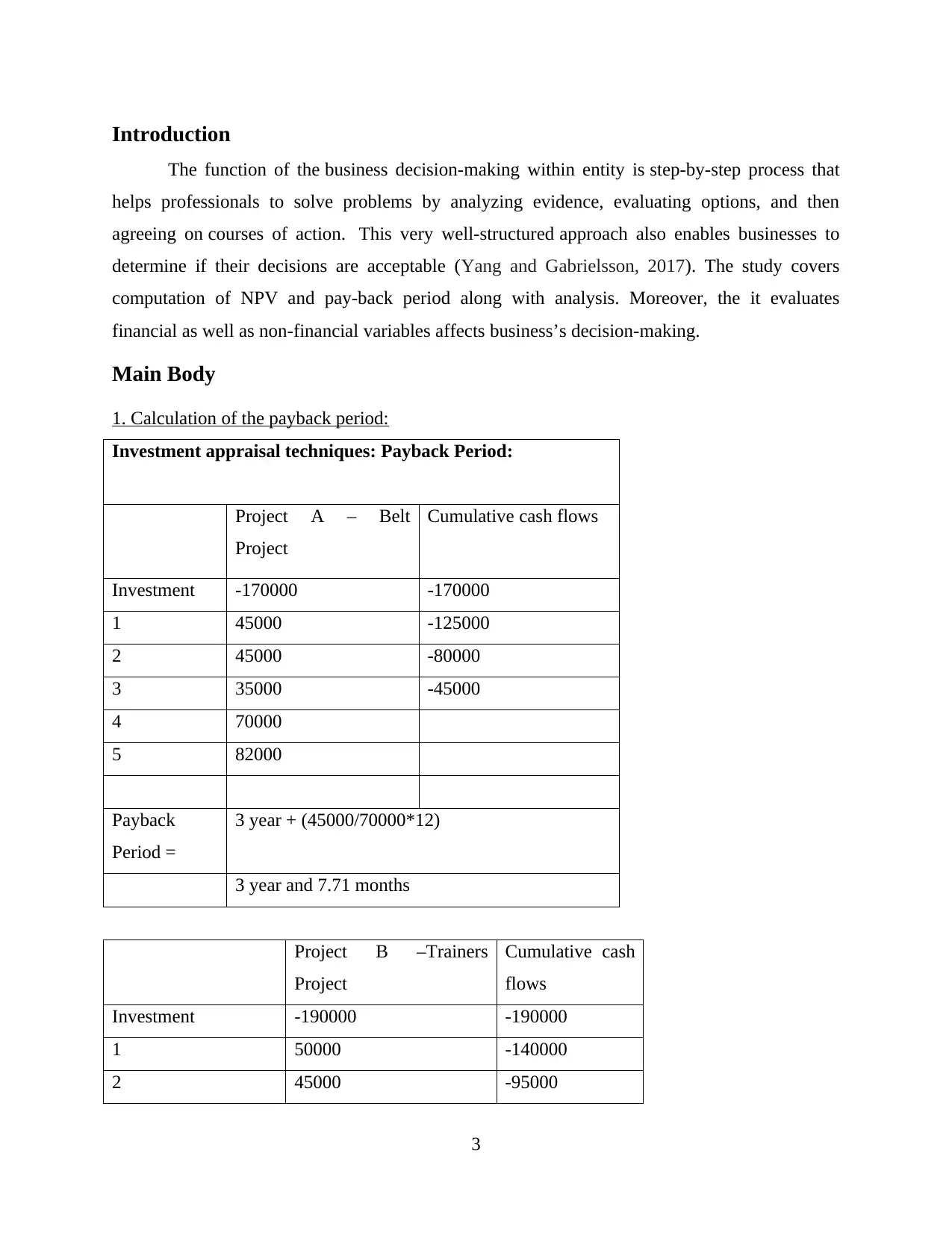
Introduction
The function of the business decision-making within entity is step-by-step process that
helps professionals to solve problems by analyzing evidence, evaluating options, and then
agreeing on courses of action. This very well-structured approach also enables businesses to
determine if their decisions are acceptable (Yang and Gabrielsson, 2017). The study covers
computation of NPV and pay-back period along with analysis. Moreover, the it evaluates
financial as well as non-financial variables affects business’s decision-making.
Main Body
1. Calculation of the payback period:
Investment appraisal techniques: Payback Period:
Project A – Belt
Project
Cumulative cash flows
Investment -170000 -170000
1 45000 -125000
2 45000 -80000
3 35000 -45000
4 70000
5 82000
Payback
Period =
3 year + (45000/70000*12)
3 year and 7.71 months
Project B –Trainers
Project
Cumulative cash
flows
Investment -190000 -190000
1 50000 -140000
2 45000 -95000
3
The function of the business decision-making within entity is step-by-step process that
helps professionals to solve problems by analyzing evidence, evaluating options, and then
agreeing on courses of action. This very well-structured approach also enables businesses to
determine if their decisions are acceptable (Yang and Gabrielsson, 2017). The study covers
computation of NPV and pay-back period along with analysis. Moreover, the it evaluates
financial as well as non-financial variables affects business’s decision-making.
Main Body
1. Calculation of the payback period:
Investment appraisal techniques: Payback Period:
Project A – Belt
Project
Cumulative cash flows
Investment -170000 -170000
1 45000 -125000
2 45000 -80000
3 35000 -45000
4 70000
5 82000
Payback
Period =
3 year + (45000/70000*12)
3 year and 7.71 months
Project B –Trainers
Project
Cumulative cash
flows
Investment -190000 -190000
1 50000 -140000
2 45000 -95000
3
⊘ This is a preview!⊘
Do you want full access?
Subscribe today to unlock all pages.

Trusted by 1+ million students worldwide

3 70000 -25000
4 90000
5 90000
Payback Period = 3 year + (25000/90000*12)
3 year and 3.33 month
2. Calculation of NPV:
NPV:
Project A –
Belt Project
PV @ 1.14 PV of Cash flows
1 45000 0.8772 39473.68
2 45000 0.7695 34626.04
3 35000 0.6750 23624.00
4 70000 0.5921 41445.62
5 82000 0.5194 42588.23
181757.58
Initial Net-investment 170000
NPV 11757.58
Project B –
Trainers
Project
PV @ 1.14 PV of Cash flows
1 50000 0.8772 43859.65
2 45000 0.7695 34626.04
3 70000 0.6750 47248.01
4 90000 0.5921 53287.22
5 90000 0.5194 46743.18
225764.10
Initial Net-investment 190000.00
4
4 90000
5 90000
Payback Period = 3 year + (25000/90000*12)
3 year and 3.33 month
2. Calculation of NPV:
NPV:
Project A –
Belt Project
PV @ 1.14 PV of Cash flows
1 45000 0.8772 39473.68
2 45000 0.7695 34626.04
3 35000 0.6750 23624.00
4 70000 0.5921 41445.62
5 82000 0.5194 42588.23
181757.58
Initial Net-investment 170000
NPV 11757.58
Project B –
Trainers
Project
PV @ 1.14 PV of Cash flows
1 50000 0.8772 43859.65
2 45000 0.7695 34626.04
3 70000 0.6750 47248.01
4 90000 0.5921 53287.22
5 90000 0.5194 46743.18
225764.10
Initial Net-investment 190000.00
4
Paraphrase This Document
Need a fresh take? Get an instant paraphrase of this document with our AI Paraphraser
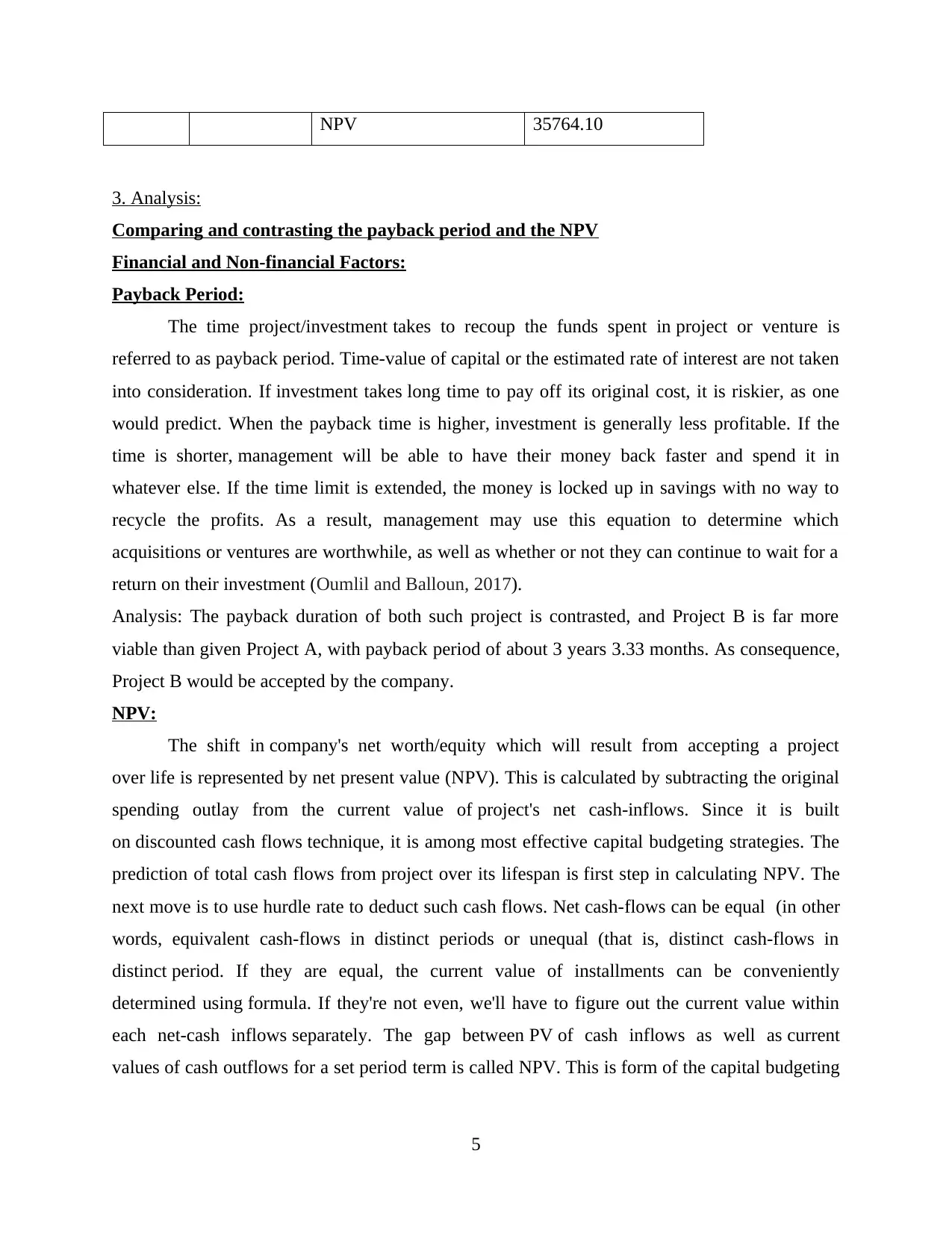
NPV 35764.10
3. Analysis:
Comparing and contrasting the payback period and the NPV
Financial and Non-financial Factors:
Payback Period:
The time project/investment takes to recoup the funds spent in project or venture is
referred to as payback period. Time-value of capital or the estimated rate of interest are not taken
into consideration. If investment takes long time to pay off its original cost, it is riskier, as one
would predict. When the payback time is higher, investment is generally less profitable. If the
time is shorter, management will be able to have their money back faster and spend it in
whatever else. If the time limit is extended, the money is locked up in savings with no way to
recycle the profits. As a result, management may use this equation to determine which
acquisitions or ventures are worthwhile, as well as whether or not they can continue to wait for a
return on their investment (Oumlil and Balloun, 2017).
Analysis: The payback duration of both such project is contrasted, and Project B is far more
viable than given Project A, with payback period of about 3 years 3.33 months. As consequence,
Project B would be accepted by the company.
NPV:
The shift in company's net worth/equity which will result from accepting a project
over life is represented by net present value (NPV). This is calculated by subtracting the original
spending outlay from the current value of project's net cash-inflows. Since it is built
on discounted cash flows technique, it is among most effective capital budgeting strategies. The
prediction of total cash flows from project over its lifespan is first step in calculating NPV. The
next move is to use hurdle rate to deduct such cash flows. Net cash-flows can be equal (in other
words, equivalent cash-flows in distinct periods or unequal (that is, distinct cash-flows in
distinct period. If they are equal, the current value of installments can be conveniently
determined using formula. If they're not even, we'll have to figure out the current value within
each net-cash inflows separately. The gap between PV of cash inflows as well as current
values of cash outflows for a set period term is called NPV. This is form of the capital budgeting
5
3. Analysis:
Comparing and contrasting the payback period and the NPV
Financial and Non-financial Factors:
Payback Period:
The time project/investment takes to recoup the funds spent in project or venture is
referred to as payback period. Time-value of capital or the estimated rate of interest are not taken
into consideration. If investment takes long time to pay off its original cost, it is riskier, as one
would predict. When the payback time is higher, investment is generally less profitable. If the
time is shorter, management will be able to have their money back faster and spend it in
whatever else. If the time limit is extended, the money is locked up in savings with no way to
recycle the profits. As a result, management may use this equation to determine which
acquisitions or ventures are worthwhile, as well as whether or not they can continue to wait for a
return on their investment (Oumlil and Balloun, 2017).
Analysis: The payback duration of both such project is contrasted, and Project B is far more
viable than given Project A, with payback period of about 3 years 3.33 months. As consequence,
Project B would be accepted by the company.
NPV:
The shift in company's net worth/equity which will result from accepting a project
over life is represented by net present value (NPV). This is calculated by subtracting the original
spending outlay from the current value of project's net cash-inflows. Since it is built
on discounted cash flows technique, it is among most effective capital budgeting strategies. The
prediction of total cash flows from project over its lifespan is first step in calculating NPV. The
next move is to use hurdle rate to deduct such cash flows. Net cash-flows can be equal (in other
words, equivalent cash-flows in distinct periods or unequal (that is, distinct cash-flows in
distinct period. If they are equal, the current value of installments can be conveniently
determined using formula. If they're not even, we'll have to figure out the current value within
each net-cash inflows separately. The gap between PV of cash inflows as well as current
values of cash outflows for a set period term is called NPV. This is form of the capital budgeting
5
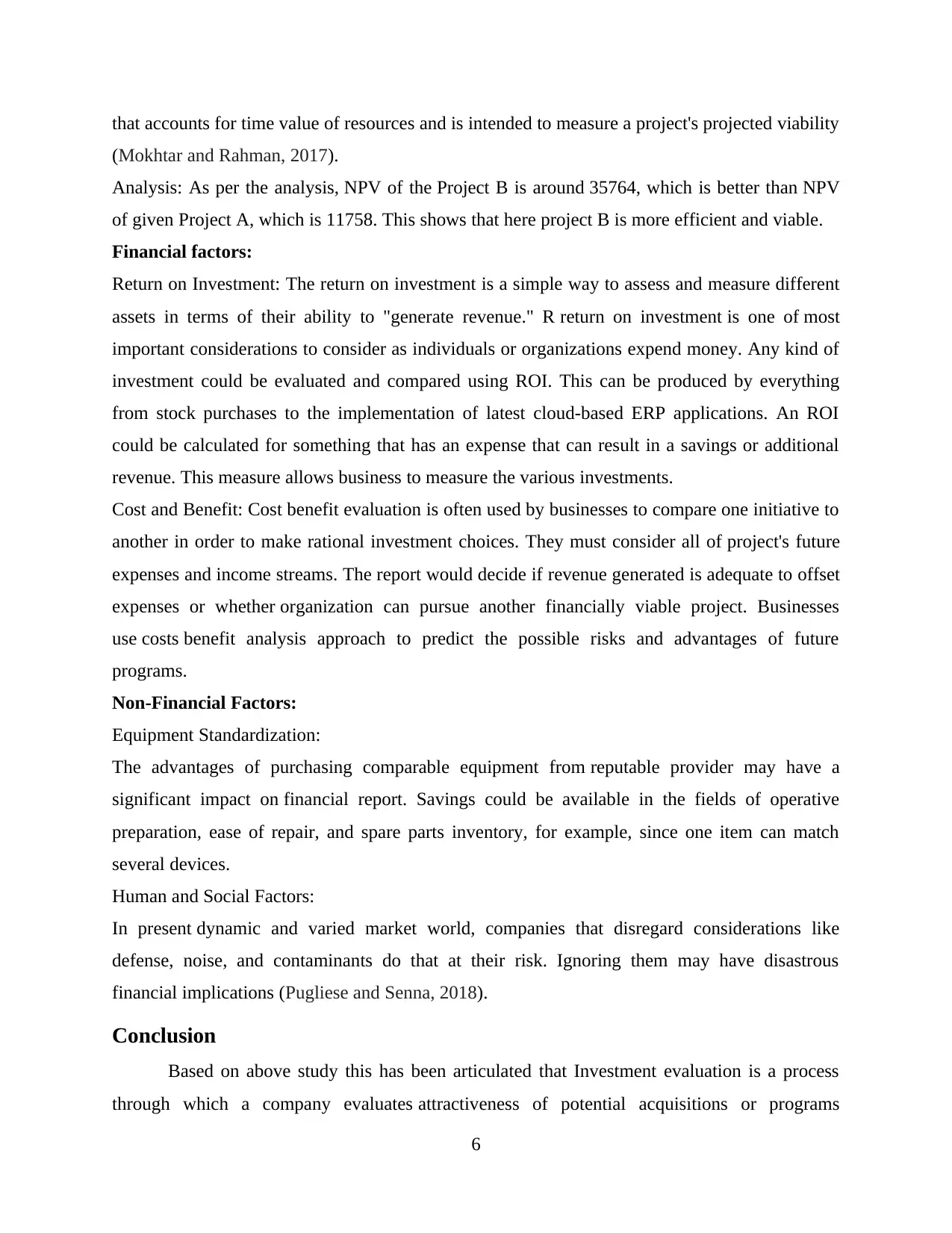
that accounts for time value of resources and is intended to measure a project's projected viability
(Mokhtar and Rahman, 2017).
Analysis: As per the analysis, NPV of the Project B is around 35764, which is better than NPV
of given Project A, which is 11758. This shows that here project B is more efficient and viable.
Financial factors:
Return on Investment: The return on investment is a simple way to assess and measure different
assets in terms of their ability to "generate revenue." R return on investment is one of most
important considerations to consider as individuals or organizations expend money. Any kind of
investment could be evaluated and compared using ROI. This can be produced by everything
from stock purchases to the implementation of latest cloud-based ERP applications. An ROI
could be calculated for something that has an expense that can result in a savings or additional
revenue. This measure allows business to measure the various investments.
Cost and Benefit: Cost benefit evaluation is often used by businesses to compare one initiative to
another in order to make rational investment choices. They must consider all of project's future
expenses and income streams. The report would decide if revenue generated is adequate to offset
expenses or whether organization can pursue another financially viable project. Businesses
use costs benefit analysis approach to predict the possible risks and advantages of future
programs.
Non-Financial Factors:
Equipment Standardization:
The advantages of purchasing comparable equipment from reputable provider may have a
significant impact on financial report. Savings could be available in the fields of operative
preparation, ease of repair, and spare parts inventory, for example, since one item can match
several devices.
Human and Social Factors:
In present dynamic and varied market world, companies that disregard considerations like
defense, noise, and contaminants do that at their risk. Ignoring them may have disastrous
financial implications (Pugliese and Senna, 2018).
Conclusion
Based on above study this has been articulated that Investment evaluation is a process
through which a company evaluates attractiveness of potential acquisitions or programs
6
(Mokhtar and Rahman, 2017).
Analysis: As per the analysis, NPV of the Project B is around 35764, which is better than NPV
of given Project A, which is 11758. This shows that here project B is more efficient and viable.
Financial factors:
Return on Investment: The return on investment is a simple way to assess and measure different
assets in terms of their ability to "generate revenue." R return on investment is one of most
important considerations to consider as individuals or organizations expend money. Any kind of
investment could be evaluated and compared using ROI. This can be produced by everything
from stock purchases to the implementation of latest cloud-based ERP applications. An ROI
could be calculated for something that has an expense that can result in a savings or additional
revenue. This measure allows business to measure the various investments.
Cost and Benefit: Cost benefit evaluation is often used by businesses to compare one initiative to
another in order to make rational investment choices. They must consider all of project's future
expenses and income streams. The report would decide if revenue generated is adequate to offset
expenses or whether organization can pursue another financially viable project. Businesses
use costs benefit analysis approach to predict the possible risks and advantages of future
programs.
Non-Financial Factors:
Equipment Standardization:
The advantages of purchasing comparable equipment from reputable provider may have a
significant impact on financial report. Savings could be available in the fields of operative
preparation, ease of repair, and spare parts inventory, for example, since one item can match
several devices.
Human and Social Factors:
In present dynamic and varied market world, companies that disregard considerations like
defense, noise, and contaminants do that at their risk. Ignoring them may have disastrous
financial implications (Pugliese and Senna, 2018).
Conclusion
Based on above study this has been articulated that Investment evaluation is a process
through which a company evaluates attractiveness of potential acquisitions or programs
6
⊘ This is a preview!⊘
Do you want full access?
Subscribe today to unlock all pages.

Trusted by 1+ million students worldwide

depending on the results of various capital budgeting including funding techniques. This is form
of fundamental research for market participants and it can assist in identifying long-term patterns
and also a corporation's potential profitability.
7
of fundamental research for market participants and it can assist in identifying long-term patterns
and also a corporation's potential profitability.
7
Paraphrase This Document
Need a fresh take? Get an instant paraphrase of this document with our AI Paraphraser
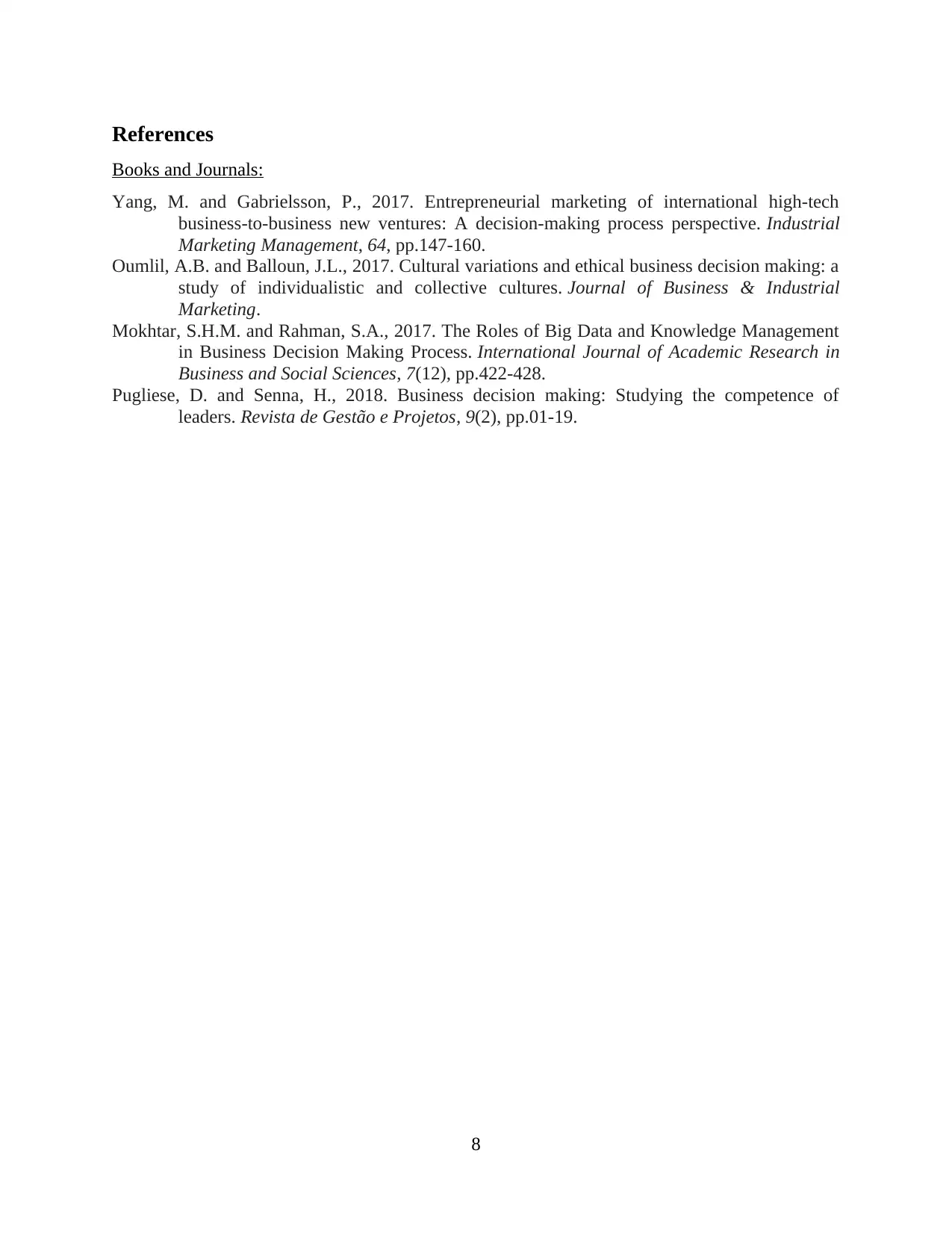
References
Books and Journals:
Yang, M. and Gabrielsson, P., 2017. Entrepreneurial marketing of international high-tech
business-to-business new ventures: A decision-making process perspective. Industrial
Marketing Management, 64, pp.147-160.
Oumlil, A.B. and Balloun, J.L., 2017. Cultural variations and ethical business decision making: a
study of individualistic and collective cultures. Journal of Business & Industrial
Marketing.
Mokhtar, S.H.M. and Rahman, S.A., 2017. The Roles of Big Data and Knowledge Management
in Business Decision Making Process. International Journal of Academic Research in
Business and Social Sciences, 7(12), pp.422-428.
Pugliese, D. and Senna, H., 2018. Business decision making: Studying the competence of
leaders. Revista de Gestão e Projetos, 9(2), pp.01-19.
8
Books and Journals:
Yang, M. and Gabrielsson, P., 2017. Entrepreneurial marketing of international high-tech
business-to-business new ventures: A decision-making process perspective. Industrial
Marketing Management, 64, pp.147-160.
Oumlil, A.B. and Balloun, J.L., 2017. Cultural variations and ethical business decision making: a
study of individualistic and collective cultures. Journal of Business & Industrial
Marketing.
Mokhtar, S.H.M. and Rahman, S.A., 2017. The Roles of Big Data and Knowledge Management
in Business Decision Making Process. International Journal of Academic Research in
Business and Social Sciences, 7(12), pp.422-428.
Pugliese, D. and Senna, H., 2018. Business decision making: Studying the competence of
leaders. Revista de Gestão e Projetos, 9(2), pp.01-19.
8
1 out of 8
Related Documents
Your All-in-One AI-Powered Toolkit for Academic Success.
+13062052269
info@desklib.com
Available 24*7 on WhatsApp / Email
![[object Object]](/_next/static/media/star-bottom.7253800d.svg)
Unlock your academic potential
Copyright © 2020–2025 A2Z Services. All Rights Reserved. Developed and managed by ZUCOL.





